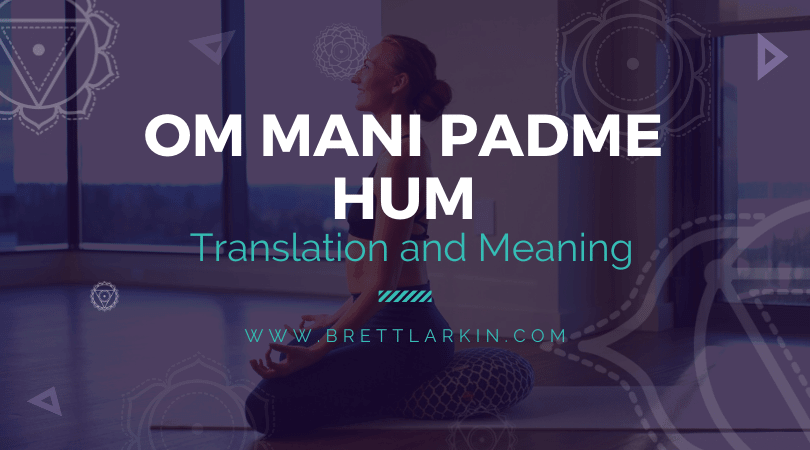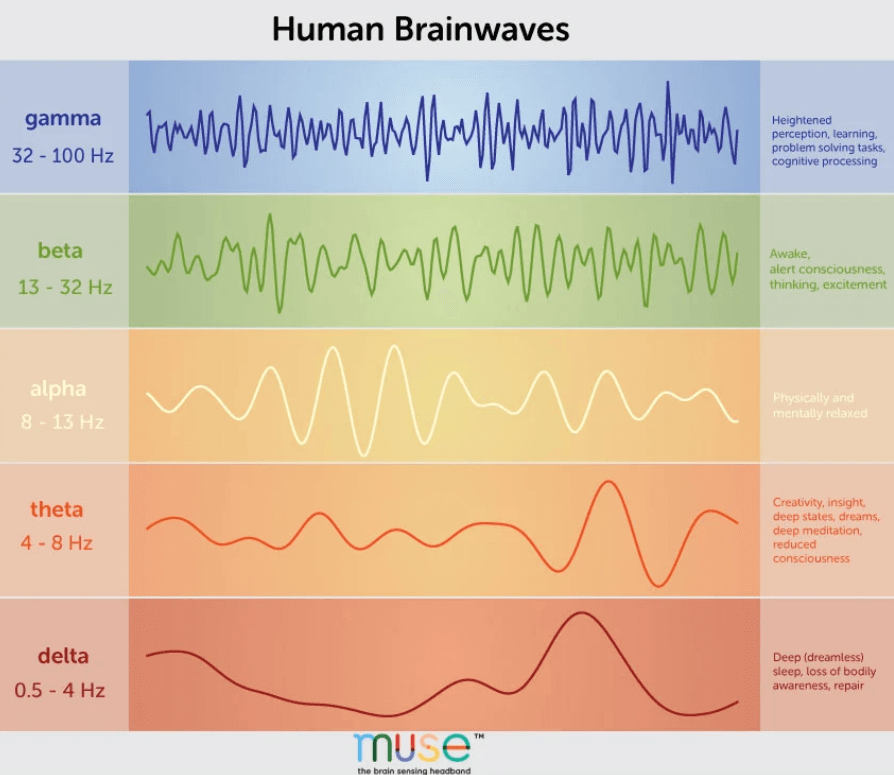
Mantras are used ALL of the time in yoga, especially when it comes to meditation.
Every mantra has a meaning, both in the verbal sense and the energetic sense.
Mantra meditation largely employs the utterance of words or the use of a mentally repeated word or phrase targeted at attaining focused attention on a specific object or goal.
So depending on what you want to achieve with your practice, you’ll choose a mantra that helps you do it.
The term mantra comes from Sanskrit and means an instrument of thought, and sacred text. “Mantras” can help us reinstate lost self-esteem, discipline, motivation, and more.
And one of the most popular spiritual mantras of all time is “Om Mani Padme Hum”, which is exactly what I’m going to break down in this post.
Om Mani Padme Hum Origins
It is said that the mantra Om Mani Padme Hum originated from one of the Mahayana Sutra, i.e. the Karandavyuha Sutra, which includes the Avalokitesvara’s manifestations and works. In Tibetan Buddhism, in particular, the Karandavyuha Sutra is one of the most significant texts.
The Mantra in Buddhism
The most significant mantra associated with a bodhisattva is the six syllables Buddhist chant, Om Mani Padme Hum.
This mantra is found carved and painted on rocks or on hillsides wherever a Tibetan Buddhist settlement exists. This mantra is written on paper and mounted on the prayer wheels that line the outside walls of Buddhist monasteries and temples in various shapes and sizes.

Tibetan Buddhists are often seen with hand-held prayer wheels accompanied by prayer beads when reciting this mantra. It is known that the entire Tibetan Buddhist world vibrates with the vibrations created by reciting the Avalokitesvara mantra, which is an important aspect of understanding resonance.
The Mantra in Hinduism
The six syllable mantra is said to have been conceptualized or evolved from ‘Siva’s’ or ‘Siva’s’ five-syllable mantra “Om Namaḥ Sivaya” since the Karandavyuha Sūtra has close affinities with non-Buddhist literature. The similarity of the frequency patterns of these two mantras provide significant proof of the Om Maṇi Padme Hum mantra being a derivative of the Om Namah Sivaya mantra.
Om Mani Padme Hum Meaning (Sanskrit ॐ मणि पद्मे हूँ, oṃ maṇi Padme hūṃ)
The core enunciation of Om Mani Padme Hum comes from Tibetan Buddhism and has several implications and meanings attached to it.
For the Tibetan Buddhists affiliated with the bodhisattva-Avalokiteśvara, the six syllables uttered in Om Mani Padme Hum make it the most significant mantra. The meaning of this rhythmic chant in English can be interpreted as “Praise to the Jewel in the Lotus”.
According to His Holiness the 14th Dalai Lama, the mantra should be recited with a focused concentration on its actual meaning.
Each of the six syllables carries significant meaning and when we focus on the meaning while using the mantra, we are better able to slip into a deep state of dharana, the 6th limb of yoga.
The meaning of the six syllables of Om Mani Padme Hum
The six syllables Om Mani Padme Hum helps achieve perfection, which is said to be as the mind of a Buddha. Although this is better known for its Buddhist ties, it can also be used in your yoga practice during mantra meditation.

Om
OṂ, in this case, is like setting the intention to become enlightened. By chanting OṂ at the start of the mantra, we are connecting with energy that will drive us through this practice and, ultimately, through transformation.
In yoga, OṂ is the original sound of the universe. It’s the humming vibration that the universe makes as it unfolds into existence. When we invoke this bija mantra, we are aligning ourselves with the great and vast universal energy. In Buddhism, OṂ symbolizes the practitioner and represents the impure body, speech, and mind of the human. When we chant this sound, we can slowly transform your impure body into the likeness of this Buddha with pure exalted body, speech, and mind.
In fact, that’s how the Buddha came to be enlightened, by purifying his body, speech, and mind.
Key Takeaway: OṂ sets the intention for our practice.

Mani
Mani literally translates to “jewel” or “bead”. Just as a jewel can save us from poverty, so too can this mantra save us from spiritual poverty. In this way, mani represents our dedication to the methods (aka chanting mantras) for achieving an altruistic intention to become compassionate and loving.
When broken down, Ma helps us practice pure ethics and Ni helps us develop tolerance and patience.
Key Takeaway: Just like OṂ helps us get in the right headspace for this practice, mani helps us get in the right heart space.

Padme
The two syllables in the word Padme translate to “lotus”, which traditionally symbolizes wisdom and purity. Just as the lotus flower grows out of mud, but is not stained by the mud, so too does wisdom grow out of conflict without being stained by it.
In yoga, this is a huge part of our practice. We are constantly learning how to step out of our human selves and view reality from our spiritual selves.
And if you want to take it a step further, many would argue that we don’t even have a ‘spiritual self’, but are simply a drop in the vast pool of the single universal consciousness. When we can connect with that and remember that during the most frustratingly tough times this reality will inevitably bring, then we can emerge from them like a lotus emerges from the mud.
Key Takeaway: Padme reminds us to not be attached to the conflict that we experience.

Hum
The final syllable hum is the indivisible union of method (aka your dependence on the practice) and the wisdom you can transform into enlightenment. Thus the six syllables symbolize purity and can be achieved by the unity of method and wisdom.
“So in this way recitation of the mantra helps achieve perfection in the six practices from generosity to wisdom. The path of these six perfections is the path walked by all the Buddhas of the three times. What could then be more meaningful than to say the mantra and accomplish the six perfections?”
—Dilgo Khyentse Rinpoche, Heart Treasure of the Enlightened Ones
Key Takeaway: Hum is method and wisdom symbolized in the final syllable of this mantra.
Om Mani Padme Hum Benefits
Om Mani Padme Hum is an incredible chant and in each and every syllable there seems to be magic that makes it more phenomenal. The merits of reciting this Mantra are infinite, and even Buddha could not completely explain it. The frequencies associated with each syllable can be actuated by chanting this mantra to resonate at frequencies known to bring a shift at a physical and biological level. Some of the benefits associated with chanting this mantra are:
Awaken Consciousness
The best way to awaken the consciousness inside is to recite a mantra and it will demonstrate a calming effect on the body and help achieve perfection.
The mantra Om Mani Padme Hum, in particular, is a great expression of love and compassion of all the Buddhas. This encourages us to cultivate love and compassion in order to make our lives full of meaning. This mantra can also provide healing and used as a prayer for all sentient beings.
For the Om Mani Padme Hum mantra, the frequencies associated with the syllable OM will show a direct impact on the body and is thus the most significant and effective mantra for Buddhist meditation.
Buddhist philosophy also states that a practitioner’s impure body, speech, and mind can be transformed into pure ones by chanting the OM syllable. It is said that this transformation is a consequence of the frequencies generated while chanting this syllable interacting with gamma waves.
Improve the nervous system
The syllable OM is considered to be a holy syllable. In order to understand the sound ‘OM’ and its effect on the nervous system, a group of researchers carried out a study that looked at exactly that. The group verified this chant as a brain stabilizer and proposed that one would enter deeper and deeper into one’s own natural state by practicing it.
Increased mental activity/cognitive development
The way the mantra impacts cognition all comes down to the vibrations made while chanting the mantra.
In fact, many in the pseudo-science and neo-yoga circles are trying to replicate those same effects with brain wave exercises.
Brain wave exercise, often referred to as a binaural beat, is becoming a common way of inducing and accessing our untapped capacity in desired mental states.
Binaural beats are aural sounds played at various frequencies in each ear. The 170.66 Hz frequency is very close to 174 Hz, which is part of the ancient Solfeggio scale and often believed to be a natural anesthetic because it helps to minimize physical and energetic pain.

In the mantra, the OM consists of three frequencies – 110.76 Hz, 170.66 Hz, and 289.13 Hz, where the first frequency of 110.76 Hz is part of the gamma wave frequencies recorded in the brain and thus facilitates the entry of gamma brainwaves.
Increased mental activity/cognitive development, freedom from distractibility, high levels of info-processing, learning and concentration, high short-term memory capability, and migraine prevention have been shown by gamma wave activity.
The syllable MA is made up of five frequencies, of which two frequencies are unique to that syllable. The 139.86 Hz frequency is part of the gamma wave sequence that is considered to demonstrate enhanced mental activity/cognitive development.
Similar frequencies are seen in the syllables NI and PAD, where some of the frequencies also match the syllable MA. The NI syllable has a frequency of 377.23 Hz, close to 396 Hz, which is also part of the ancient Solfeggio scale. It cleanses the sense of guilt, which is also one of the underlying barriers to success, allowing tasks to be accomplished in the most direct way. The frequency of 396 Hz explores latent blockages, implicit pessimistic attitudes, and thoughts that have contributed to your current circumstances.
The ME and HUM syllables also display a common frequency pattern that overlaps with other patterns of the syllable. 122.76 Hz and 122.1 Hz are also part of the sequence of gamma waves that are considered to display increased mental activity/cognitive development, freedom from distraction, high levels of info-processing, learning and concentration, high short-term memory capacity, and prevention of migraine.
How To Use Om Mani Padme Hum Mantra Meditation
- In a quiet room, where you won’t bother or be bothered by anyone, sit cross-legged on a cushion.
- In order to clear your mind, breathe deeply for a minute. Then begin slowly in a low, quiet voice to recite the mantra Om Mani Padme Hum. Return to relying on the mantra when emotions interfere.
- After a few minutes continue to chant the mantra and begin to imagine your words touching all beings and relieving them from their misery. Make sure to include yourself.
- Do this for at least 21 preferably 108 recitations or one round on a prayer bead necklace.
- End your meditation with a few minutes of sitting quietly and concentrating on your breath.
Next Steps
- If you’re interested in practical kriya yoga as a way to improve your daily life and relationships, check out my Yoga for Self Mastery course.
- Order my Yoga Life book for a practical guide to creating balance in your life through yoga.
- Check out my YouTube channel and find some yoga classes that you can try out for yourself!
Experience 3 Training Videos from Inside My 200-Hour Online YTT

YOU MIGHT ALSO LIKE
- What is Kriya Yoga? The Philosophy and Practice
- Uddiyana Bandha: Tapping Into Your Deep Core
- 4 Reasons Hasta Bandha Is Essential To Your Yoga Practice
- Vitarka Mudra: What It Is and How Do You Use It?
- Shakti Mudra: What It Is and How Do You Do It?
- Garuda Mudra: What It Is and How Do You Use It?
- Kali Mudra: What It Is and How Do You Do It?
- Shunya Mudra: What It Is and How Do You Do It?
- Varuna Mudra: What It Is and How Do You Use It?
- Vayu Mudra: What It Is and How Do You Use It?
- Samana Vayu: The Energy of Balance & How to Access It
- Apana Vayu: The Energy of Release & Surrender
- Udana Vayu: The Ascending Wind
- Prana Vayu: The Breath of Vitality
- Vyana Vayu: The Energetic Secret to Flow
Learn how to do 11 of the most popular yoga poses correctly. Free video + PDF download.












